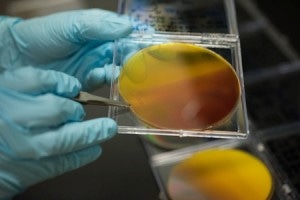Mar 7 2017
 Scientists at JCAP create new materials by spraying combinations of elements onto thin plates. CREDIT: Caltech.
Scientists at JCAP create new materials by spraying combinations of elements onto thin plates. CREDIT: Caltech.
In a time span of just two years, scientists from Caltech and Lawrence Berkeley National Laboratory, or Berkeley Lab, have almost doubled the number of materials that can be potentially used in solar fuels.
In order to achieve this, the researchers developed a technique that assures to accelerate the finding of commercially practicable solar fuels that can be used as substitutes for oil, coal, and other fossil fuels.
A dream of clean-energy research, solar fuels are developed using only sunlight, water, and carbon dioxide (CO2). Scientists are constantly looking for a wide array of target fuels, from liquid hydrocarbons to such hydrogen gas. The production of such fuels involves splitting water.
Each water molecule is formed of two hydrogen atoms and an oxygen atom. The hydrogen atoms are extracted and then recombined to form highly flammable hydrogen gas, or the hydrogen atoms can be combined with CO2 to form hydrocarbon fuels, producing an abundant renewable energy source.
However, the main challenge is that water molecules are not easily broken down during exposure to sunlight. For this, a little help from a solar-powered catalyst is needed.
In order to develop practical solar fuels, researchers have been working hard to create efficient and inexpensive materials called photoanodes that can split water using visible light as the energy source. For nearly 40 years, only 16 such photoanode materials have been identified by researchers.
Now, a research group, headed by John Gregoire from Caltech and Jeffrey Neaton and Qimin Yan from Berkeley Lab, discovered 12 new promising photoanodes. They achieved this by employing a new high-throughput technique of identifying new materials.
A paper describing the technique as well as the new photoanodes has been published online in the Proceedings of the National Academy of Sciences (PNAS) on March 6. The new technique was created by a partnership between the Joint Center for Artificial Photosynthesis (JCAP) at Caltech and the Berkeley Lab’s Materials Project, by using resources from the Molecular Foundry and the National Energy Research Scientific Computing Center (NERSC).
“This integration of theory and experiment is a blueprint for conducting research in an increasingly interdisciplinary world. It’s exciting to find 12 new potential photoanodes for making solar fuels, but even more so to have a new materials discovery pipeline going forward.”
John Gregoire, Caltech
Gregoir is the JCAP thrust coordinator for Photoelectrocatalysis and leader of the High Throughput Experimentation group
“What is particularly significant about this study, which combines experiment and theory, is that in addition to identifying several new compounds for solar fuel applications, we were also able to learn something new about the underlying electronic structure of the materials themselves,” stated Neaton, director of the Molecular Foundry.
Former materials discovery techniques relied on complex testing of individual compounds to evaluate for the possibility of their use in particular applications.
In the new technique, Gregoire and his collaborators integrated experimental and computational methods by initially surveying a materials database for prospectively useful compounds, screening the database with respect to characteristics of the materials, and then quickly testing the most probable compounds through high-throughput experimentation.
In the study reported in the PNAS paper, they investigated a total of 174 metal vanadates, that is, compounds formed of oxygen and vanadium in addition to another element from the periodic table.
According to Gregoire the study describes the way in which materials with different characteristics can be produced by altering the choices for the third element, and also shows how to “tune” the characteristics to produce the optimum photoanode.
The key advance made by the team was to combine the best capabilities enabled by theory and supercomputers with novel high throughput experiments to generate scientific knowledge at an unprecedented rate.
John Gregoire, Caltech